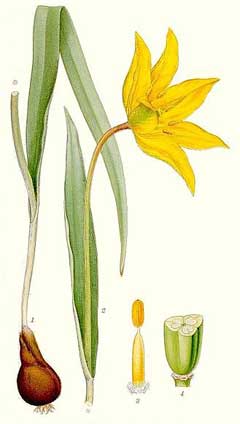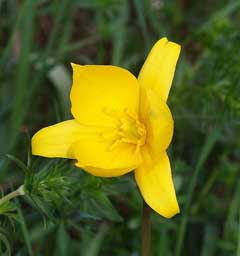 |
|
commons.wikimedia.org/wiki/File:383_Tulipa_silvestris.jpg |
 |
| commons.wikimedia.org/wiki/User:BerndH |
Translate this page:
Summary
Physical Characteristics

 Tulipa sylvestris is a BULB growing to 0.3 m (1ft).
Tulipa sylvestris is a BULB growing to 0.3 m (1ft).
See above for USDA hardiness. It is hardy to UK zone 5 and is not frost tender. It is in flower from April to May. The species is hermaphrodite (has both male and female organs) and is pollinated by Insects. The plant is self-fertile.
Suitable for: light (sandy), medium (loamy) and heavy (clay) soils and prefers well-drained soil. Suitable pH: mildly acid, neutral and basic (mildly alkaline) soils. It can grow in semi-shade (light woodland) or no shade. It prefers moist soil.
UK Hardiness Map
US Hardiness Map
Synonyms
T. florentina.
Plant Habitats
Lawn; Cultivated Beds;
Edible Uses
References More on Edible Uses
Medicinal Uses
Plants For A Future can not take any responsibility for any adverse effects from the use of plants. Always seek advice from a professional before using a plant medicinally.
None known
References More on Medicinal Uses
The Bookshop: Edible Plant Books
Our Latest books on Perennial Plants For Food Forests and Permaculture Gardens in paperback or digital formats.

Edible Tropical Plants
Food Forest Plants for Hotter Conditions: 250+ Plants For Tropical Food Forests & Permaculture Gardens.
More

Edible Temperate Plants
Plants for Your Food Forest: 500 Plants for Temperate Food Forests & Permaculture Gardens.
More

More Books
PFAF have eight books available in paperback and digital formats. Browse the shop for more information.
Shop Now
Other Uses
References More on Other Uses
Cultivation details
Easily grown in a well-drained soil[90]. It can be naturalized in short grass[90]. The plant is often found growing in chalk pits in the wild and so should do well on alkaline soils[245]. The plant can increase quite rapidly by means of underground stolons and can be difficult to eradicate[245]. Bulbs can be harvested after the plants have died down in July, stored in a cool dry place and then replanted in October[1]. The flowers have a most pronounced perfume[245]. This species is in cultivation in Britain under the name 'Tabriz'[90].
References Carbon Farming Information and Carbon Sequestration Information
Temperature Converter
Type a value in the Celsius field to convert the value to Fahrenheit:
Fahrenheit:
The PFAF Bookshop
Plants For A Future have a number of books available in paperback and digital form. Book titles include Edible Plants, Edible Perennials, Edible Trees,Edible Shrubs, Woodland Gardening, and Temperate Food Forest Plants. Our new book is Food Forest Plants For Hotter Conditions (Tropical and Sub-Tropical).
Shop Now
Plant Propagation
Seed - best sown in a shady part of the cold frame as soon as it is ripe in early summer[1], or in the early autumn[200]. A spring sowing of stored seed in the greenhouse also succeeds[K]. Sow the seed thinly so that the seedlings can be grown on without disturbance for their first growing season - apply liquid feeds to the pot if necessary. Divide the bulbs once the plants have become dormant, putting 3 - 4 bulbs in each pot. Grow the on in the greenhouse for at least the next year, planting them out when dormant. Division of offsets in July. Larger bulbs can be planted out straight into their permanent positions, or can be stored in a cool place and then be planted out in late autumn. It is best to pot up smaller bulbs and grow them on in a cold frame for a year before planting them out when they are dormant in late summer to the middle of autumn.
Other Names
If available other names are mentioned here
Native Range
TEMPERATE ASIA: Turkey EUROPE: Switzerland, Belarus, Ukraine, Albania, Bulgaria, Bosnia and Herzegovina, Greece, Croatia, Italy, North Macedonia, Montenegro, Romania, Serbia, Slovenia, Spain, France, Portugal AFRICA: Algeria, Libya, Morocco, Tunisia
Weed Potential
Right plant wrong place. We are currently updating this section.
Please note that a plant may be invasive in one area but may not in your area so it's worth checking.
Conservation Status
IUCN Red List of Threatened Plants Status :

Growth: S = slow M = medium F = fast. Soil: L = light (sandy) M = medium H = heavy (clay). pH: A = acid N = neutral B = basic (alkaline). Shade: F = full shade S = semi-shade N = no shade. Moisture: D = dry M = Moist We = wet Wa = water.
Now available:
Food Forest Plants for Mediterranean Conditions
350+ Perennial Plants For Mediterranean and Drier Food Forests and Permaculture Gardens.
[Paperback and eBook]
This is the third in Plants For A Future's series of plant guides for food forests tailored to
specific climate zones. Following volumes on temperate and tropical ecosystems, this book focuses
on species suited to Mediterranean conditions—regions with hot, dry summers and cool, wet winters,
often facing the added challenge of climate change.
Read More
Expert comment
Author
L.
Botanical References
1750200
Links / References
For a list of references used on this page please go here
Readers comment
© 2010, Plants For A Future. Plants For A Future is a charitable company limited by guarantee, registered in England and Wales. Charity No. 1057719, Company No. 3204567.